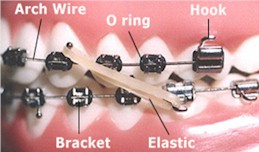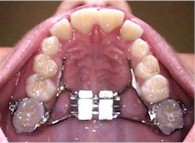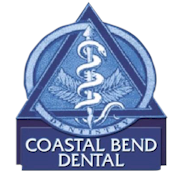|
|
2797 Main St., Ingleside, Texas 78362
Orthodontic Frequently
Asked Questions / Orthodontic Terms Orthodontic Frequently Asked Questions
What
age should my child have an orthodontic evaluation? What age should my child have an orthodontic evaluation? The American Association of Orthodontists (AAO) recommends an orthodontic screening for children by the age of 7 years. At age 7 the teeth and jaws are developed enough so that the dentist or orthodontist can see if there will be any serious bite problems in the future. Most of the time treatment is not necessary at age 7, but it gives the parents and dentist time to watch the development of the patient and decide on the best mode of treatment. When you have time on your side you can plan ahead and prevent the formation of serious problems. Why is it important to have orthodontic treatment at a young age? Research has shown that serious orthodontic problems can be more easily corrected when the patient’s skeleton is still growing and flexible. By correcting the skeletal problems at a younger age we can prepare the mouth for the eventual eruption of the permanent teeth. If the permanent teeth have adequate space to erupt they will come in fairly straight. If the teeth erupt fairly straight their tendency to get crooked again after the braces come off is diminished significantly. After the permanent teeth have erupted, usually from age 12-14, complete braces are placed for final alignment and detailing of the bite. Thus the final stage of treatment is quicker and easier on the patient. This phase of treatment usually lasts from 12 - 18 month and is not started until all of the permanent teeth are erupted. Doing orthodontic treatments in two steps provides excellent results often allowing the doctor to avoid removal of permanent teeth and jaw surgery. The treatment done when some of the baby teeth are still present is called Phase-1. The last part of treatment after all the permanent teeth have erupted is called Phase-2. The details of Early Orthodontics are listed below. Early Orthodontic (Two Phase) Treatment Early detection and treatment gives your child the edge: a much better chance for natural and normal development. By working with the natural growth instead of against it, we can prevent problems from becoming worse, and give your child a lifetime of healthy smiles! Early treatment should be initiated for:
Phase
One - Functional
(Growth) Appliances and/or Limited Braces - Ages 5 to 12
In the first
phase, the doctor is interested in the position and symmetry of the
jaws, future growth, spacing of the teeth, breathing and other oral
habits which may, over a period of time, result in abnormal dentofacial
development. Treatment
initiated in this phase of development is often very successful and some
times, though not always, can eliminate the need for future orthodontic
treatment. Phase Two - Braces - Ages 12 to 14 In the second phase, the doctor will be looking at how your child’s teeth and jaws fit, and more specifically work, together. Your child’s teeth will be straightened and their occlusion (bite) is properly aligned. Attention will be given to the jaw joint, (TMJ), the facial profile and periodontal (gum) tissues. By undergoing the first phase, we can usually reduce the amount of time needed for braces. Facts: Early Treatment is Important to Consider! Facial Development - Seventy-five percent of 12-year-olds need orthodontic treatment. Yet 90% of a child's face has already developed! By guiding facial development earlier, through the use of functional appliances, 80% of the treatment can be corrected before the adult teeth are present!Cooperation - Younger children between the ages of 8 and 11 are often much more cooperative than children of ages 12 to 14. Shorter Treatment Time - Another advantage of early Phase One treatment is that children will need to wear fixed braces on their adult teeth for less time. To
Correct Underdeveloped or Overdeveloped Jaws
- Almost 55% of children who need orthodontic treatment due to a bad
bite have underdeveloped or overdeveloped upper or lower jaws.
Functional appliances and/or limited braces can reposition the jaws,
improving the child's profile and correcting the bite problem - within 7
to 9 months! Crowded teeth, thumb sucking, tongue thrusting, premature loss of baby teeth, a poor breathing airway caused by enlarged adenoids or tonsils can all contribute to poor tooth positioning. And then there are the hereditary factors. Extra teeth, large teeth, missing teeth, wide spacing, small jaws - all can be causes of crowded teeth. Tooth movement is a natural response to light pressure over a period of time. Pressure is applied by using a variety of orthodontic hardware (appliances), the most common being a brace or bracket attached to the teeth and connected by an arch wire. Periodic changing of these arch wires puts pressure on the teeth. At different stages of treatment your child may wear a headgear, elastics, a positioner or a retainer. Most orthodontic appointments are scheduled 4 to 6 weeks apart to give the teeth time to move.
When teeth are first moved, discomfort may
result. This usually lasts about 24 to 72 hours. Patients report a
lessening of pain as the treatment progresses. Pain medicines such as
acetaminophen (Tylenol) or ibuprofen (Advil) usually help relieve the
pain. Arch
Wire / Brackets
/
Band & Loop (B&L)
The part of your braces which actually moves the teeth. The arch wire is attached to the brackets by small elastic donuts or ligature wires. Arch Wires are changed throughout the treatment. Each change brings you closer to the ideal tooth position. Brackets are the “Braces” or small attachments that are bonded directly to the tooth surface. The brackets are the part of your braces to which the dentist or assistant attaches the arch wire.
Occasionally, a bracket may come loose and
become an irritation to your mouth. You can remove the loose bracket and
save it in an envelope to bring to the office. Call the office as soon
as possible and make an appointment to re-glue the bracket. A Band & Loop is routinely used to hold space for a missing primary (baby) posterior (back) tooth until the permanent tooth can grown in. At some time during treatment, it will be necessary to wear elastics to coordinate the upper and lower teeth and perfect the bite. Once teeth begin to move in response to elastics, they move rapidly and comfortably. If elastics (rubber bands) are worn intermittently, they will continually "shock" the teeth and cause more soreness. When elastics are worn one day and left off the next, treatment slows to a standstill or stops. Sore teeth between appointments usually indicate improper wear of headgear or elastics or inadequate hygiene. Wear your elastics correctly, attaching them as you were told. Wear elastics all the time, unless otherwise directed. Take your elastics off while brushing. Change elastics as directed, usually once or twice a day.
Poor positioning of the teeth. Types of Malocclusion:
The alignment and spacing of your upper and lower teeth when you bite down.
O rings, also called A-lastics, are little
rings used to attach the arch wire to the brackets. These rings come in
standard gray or clear, but also come in a wide variety of colors to
make braces more fun. A-lastics are changed at every appointment to
maintain good attachment of the arch wire to the bracket, enabling our
patients to enjoy many different color schemes throughout treatment. Vertical overlapping of the upper teeth over the lower.
Horizontal projection of the upper teeth
beyond the lower. An appliance which is placed in the roof of the mouth to widen the upper dental arch. The maxilla, or upper dental arch, is joined in the center by a joint, which allows it to be painlessly separated and spread. Temporarily you may see a space develop between the upper two front teeth. This will slowly go away in a few days. Once this has occurred, the two halves knit back together and new bone fills in the space. Care of appliance: Brush as usual. Brush the appliance and roof of the mouth thoroughly. Rinse often to clean any food lodged between the arch and appliance.
A plastic or rubber donut piece which the
dentist uses to create space between your teeth for bands. Braces Care / Appliance Care / Elastics Care / Proper Diet You will be shown the proper care of your braces when your orthodontic treatment begins. Proper cleansing of your mouth is necessary every time you eat. Teeth with braces are harder to clean, and trap food very easily. If food is left lodged on the brackets and wires, it can cause unsightly etching of the enamel on your teeth. Your most important job is to keep your mouth clean. If food is allowed to collect, the symptoms of gum disease will show in your mouth. The gums will swell and bleed and the pressure from the disease will slow down tooth movement. BRUSHING: You should brush your teeth 4-5 times per day.
Look in a mirror to see if you have missed any places. Your teeth, brackets and wires should be free of any food particles and plaque. Note: If your gums bleed when brushing, do not avoid brushing, but rather continue stimulating the area with the bristles. Be sure to angle your toothbrush so that the area under your gum line is cleaned. After 3 or 4 days of proper brushing, the bleeding should stop and your gums should be healthy again. FLOSSING: Use a special floss threader to floss with your braces on. Be sure to floss at least once per day.
FLUORIDE RINSE OR GEL: May be
recommended for preventive measures. Clean the retainer by brushing with toothpaste. If you are wearing a lower fixed retainer be extra careful to brush the wire and the inside of the lower teeth. Always bring your retainer to each appointment. Avoid flipping the retainer with your tongue, this can cause damage to your teeth. Place the retainer in the plastic case when it is removed from your mouth. Never wrap the retainer in a paper napkin or tissue, someone may throw it away. Don't put it in your pocket or you may break or lose it. Excessive heat will warp and ruin the retainer.
If elastics (rubber bands) are worn
intermittently, they will continually "shock" the teeth and cause more
soreness. Sore teeth between appointments usually indicate improper wear
of headgear or elastics or inadequate hygiene. Wear your elastics
correctly, attaching them as you were told. Wear elastics all the time,
unless otherwise directed. Take your elastics off while brushing. Change
elastics as directed, usually once or twice a day.
Orthodontic Emergencies or Problems
Loose Bracket
/ Poking Wire
/ Wire
out of Back Brace Please feel free to contact the office if you are experiencing any discomfort or if you have any questions. Below are a few simple steps that might help if you are unable to contact us or if you need a “quick fix”. Occasionally, a glued bracket may come loose. You can remove the loose bracket and save it in an envelope to bring to the office or leave it where it is, if it is not causing any irritation. Call the office as soon as possible in order for us to allow time to re-glue the bracket.
If a wire is poking your gums or cheek there
are several things you can try until you can get to the office for an
appointment. First try a ball of wax on the wire that is causing the
irritation. You may also try using a nail clipper or cuticle cutter to
cut the extra piece of wire that is sticking out. Sometimes, a poking
wire can be safely turned down so that it no longer causes discomfort.
To do this you may use a pencil eraser, or some other smooth object, and
tuck the offending wire back out of the way. Please be careful to avoid hard or sticky foods that may bend the wire or cause it to come out of the back brace. If this does happen, you may use needle nose pliers or tweezers to put the wire back into the hole in the back brace. If you are unable to do this, you may clip the wire to ease the discomfort. Please call the office as soon as possible to schedule an appointment to replace the wire. Poking Elastic (Rubber Band) Hook
Some brackets have small hooks on them for
elastic wear. These hooks can occasionally become irritating to the lips
or cheeks. If this happens, you may either use a pencil eraser to
carefully push the hook in, or you can place a ball of wax on the
hook to make the area feel smooth. You may be experiencing some discomfort after beginning treatment or at the change of wires or adjusting of appliances. This is normal and should diminish within 24-72 hours. A few suggestions to help with the discomfort:
Home |
Meet the Staff |
Office Policies |
New Patient Info |
Dental Topics |
||||||||||||||||||||||||||||||||||||||
|
|
|||||||||||||||||||||||||||||||||||||||
|
Copyright ©
Coastal Bend Dental 2003 All Rights Reserved. Web Site Design by Dentists4Kids.com |
|||||||||||||||||||||||||||||||||||||||



